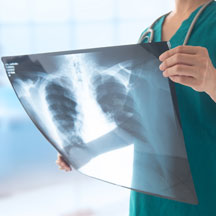Children’s Hospital of Philadelphia’s (CHOP) radiology department includes 42 pediatric radiologists on staff. Through CHA’s PROSPECT data program, CHOP was identified as a top performer for staffing efficiency. Colleen Flowers, AS, RT (R) (MR), supervisor of Operations & Process Improvement, and Caryn Karff, M.S., R. T. (R) (CT) (MR), CRA, director of Radiology Clinical Operations, credit success in staffing efficiency to partnerships across the organization and collaboration between staff and radiology leaders.
Radiology staff offer input to leaders and are involved in eliminating workarounds, silos and inefficiencies by encouraging feedback from radiology’s partners and supporting areas, like the emergency department. These principles set them up for success in a normal year but were also the foundation for flexibility during COVID-19.
Monthly meetings became weekly
Traditionally, leaders in imaging met monthly with the finance team to evaluate patient volume and assess staffing alignment. Since the onset of COVID-19, those monthly meetings became weekly to more closely assess how schedules can be tweaked to align with patient volumes and preserve resources for the duration of the crisis.
Real-time information became critical to decision-making during the pandemic and has led to long-term changes. Flowers says a new dashboard is in the works that will help the team monitor patient volumes and how volumes match up with staffing, sedation procedures, and complex and multimodality procedures. CHOP is back to nearly normal volumes after seeing a steep drop-off when elective procedures were halted in March and April of 2020, but the dashboard is a result of information needed during the pandemic. Going forward it will be used to evaluate staffing daily.
Fixed and variable schedules
CHOP is a certified Level 1 Trauma Center and provides 24-hour coverage for diagnostic, ultrasound, CT and MRI services. All other imaging services have staff on-call during overnight shifts. MRI, CT, interventional radiology, nuclear medicine, and ultrasound technologists are on fixed schedules regardless of patient volume to maintain proper safety practices.
Other areas have established flexible scheduling, which was born in diagnostic radiology (DR) several years ago following employee engagement surveys, changes in weekend programs and after leaders noticed staffing shortages during peak hours of the day. They examined volume reports to identify patterns and adjust schedules. Technologists were also expressing a desire to move to 10- and 12-hour shifts, instead of the department’s traditional eight-hour shifts.
Looking at peak volume patterns with desired longer shifts in mind, Flowers says a staggered shift schedule was developed with a few basic guidelines:
- Overnight shifts never had less than a minimum of four technologists.
- Schedules would overlap to match peak volume times.
- Nine to 11 technologists during peak dayshift hours was ideal.
- Five to six technologists during mid-shift hours was sufficient
Additionally, imaging teams needed more reliable weekend staff. Previously, CHOP had dedicated weekend technologists on staff that came with incentives. After discontinuing the incentivized weekend program, CHOP started having gaps in weekend coverages. Part-time and per diem staff were called in to support weekend volumes but were less consistent due to personal or primary job obligations
“We started rotating full-time techs through the weekend, which allowed them to have flexibility and time off during the week to protect their personal responsibilities as well,” Flowers says. “Covering open shifts doesn’t feel like it’s being mandated but rather part of their regular rotations.”
Schedules are built-in six-week intervals, sometimes longer depending on the modality and complexity of the schedule. Staff can modify their schedule as needed by swapping shifts with their peers rather than take days off, which allows CHOP to maintain staffing volumes. Shifts and coverages in schedules are approved by the team lead.
Appointment adherence
As volumes were analyzed and staffing was aligned with need, it also became important to ensure patients were showing up for appointments. CHOP uses EPIC as their electronic health record, which uses a decision tree to allow patients to self-schedule some appointments online. Appointments requiring sedation are triaged to the department scheduler, all of whom are within the imaging department on the main campus.
Once an appointment is made, digital reminders are sent to families through the My Chart feature within EPIC. A chatbot—CHOP named its Charlie—provides answers to basic questions online, such as parking instructions or how early they need to arrive for appointments. Nurses and technologists also make calls to families before appointments. Success is measured by appointment cancellations and no-show metrics.
Hiring strategies
CHOP’s hiring strategy has historically meant they hired mostly on an as-needed basis but took a proactive approach to guarantee that more difficult-to-fill staff positions had qualified prospects in the queue. For certain candidates who had experience and training in pediatrics, CHOP would try to find room in the schedule and budget to hire that person. COVID-19 has changed this approach.
“It’s hard to find good MRI techs at the drop of a hat, so we had to keep that pool alive for us to make sure that if there were unplanned vacancies, someone could step in,” Kazmi says. “Now, we’re being mindful about this. We don’t want to hire someone and then down the line realize we can’t keep them on. We’re filling positions but nowhere close to pre-COVID-19 levels.”
Cross-training
In 2020, CHOP shifted from hiring new staff to building the skills and filling hours for existing full-time staff. Flowers says the department used the months of slower volumes during the pandemic to cross-train existing staff in other modalities. This included technologists who didn’t have previous availability to complete clinical hours and now have that ability.
Areas of cross-training included:
- Diagnostic radiology into interventional.
- Nuclear medicine into CT.
- CT into nuclear medicine.
- CT into MRI.
- Diagnostic radiology into MRI.
“The idea is for us to maximize the workforce,” Kazmi says. “We want to increase the number of cross-trained staff as much as possible, not just in existing staff but in the new hiring, we’ll do. We’ll focus more on having people who are cross-trained or cross trainable.”


